This is a preprint.
The effect of type 2 diabetes genetic predisposition on non-cardiovascular comorbidities
- PMID: 40385452
- PMCID: PMC12083600
- DOI: 10.1101/2025.05.05.25326966
The effect of type 2 diabetes genetic predisposition on non-cardiovascular comorbidities
Abstract
Type 2 diabetes (T2D) is epidemiologically associated with a wide range of non-cardiovascular comorbidities, yet their shared etiology has not been fully elucidated. Leveraging eight non-overlapping mechanistic clusters of T2D genetic profiles, each representing distinct biological pathways, we investigate putative causal links between cluster-stratified T2D genetic predisposition and 21 non-cardiovascular comorbidities. Most of the identified putative causal effects are driven by distinct T2D genetic clusters. For example, the risk-increasing effects of T2D genetic predisposition on cataracts and erectile dysfunction are primarily attributed to obesity and glucose regulation mechanisms, respectively. When surveyed in populations across the globe, we observe opposing effect directions for depression, asthma and chronic obstructive pulmonary disease between populations. We identify a putative causal link between T2D genetic predisposition and osteoarthritis. To underscore the translational potential of our findings, we intersect high-confidence effector genes for osteoarthritis with targets of T2D-approved drugs and identify metformin as a potential candidate for drug repurposing in osteoarthritis.
Figures
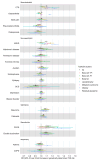
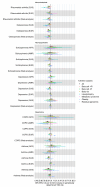

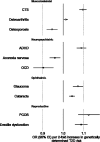
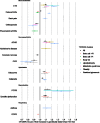
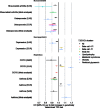
Similar articles
-
Integrative metabolomics and genomics reveal molecular signatures for type 2 diabetes and its cardiovascular complications.Cardiovasc Diabetol. 2025 Apr 16;24(1):166. doi: 10.1186/s12933-025-02718-4. Cardiovasc Diabetol. 2025. PMID: 40241080 Free PMC article.
-
Untangling the genetic link between type 1 and type 2 diabetes using functional genomics.Sci Rep. 2021 Jul 6;11(1):13871. doi: 10.1038/s41598-021-93346-x. Sci Rep. 2021. PMID: 34230558 Free PMC article.
-
Genome-wide cross-disease analyses highlight causality and shared biological pathways of type 2 diabetes with gastrointestinal disorders.Commun Biol. 2024 May 27;7(1):643. doi: 10.1038/s42003-024-06333-z. Commun Biol. 2024. PMID: 38802514 Free PMC article.
-
Shared genetic etiology underlying Alzheimer's disease and type 2 diabetes.Mol Aspects Med. 2015 Jun-Oct;43-44:66-76. doi: 10.1016/j.mam.2015.06.006. Epub 2015 Jun 23. Mol Aspects Med. 2015. PMID: 26116273 Free PMC article. Review.
-
Genetics of murine type 2 diabetes and comorbidities.Mamm Genome. 2022 Sep;33(3):421-436. doi: 10.1007/s00335-022-09948-x. Epub 2022 Feb 3. Mamm Genome. 2022. PMID: 35113203 Review.
References
Publication types
Grants and funding
LinkOut - more resources
Full Text Sources
